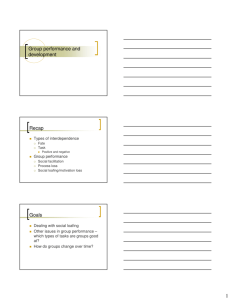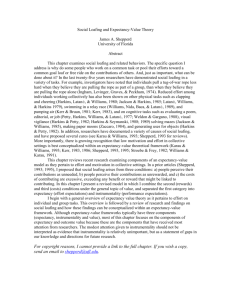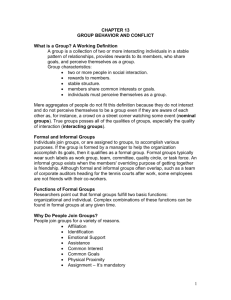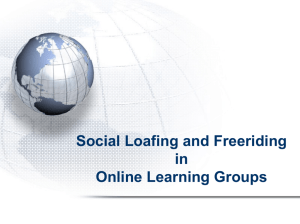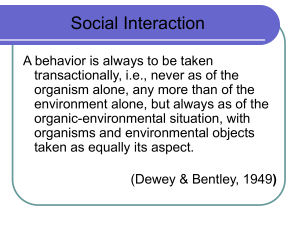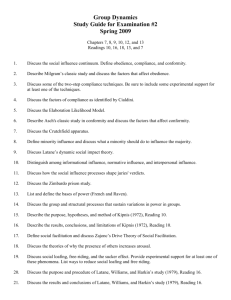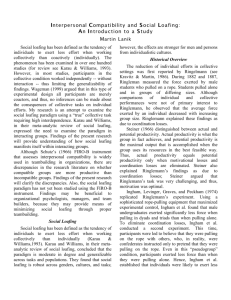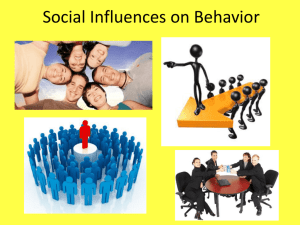What mechanisms are currently in place at CPIT to prevent social
advertisement
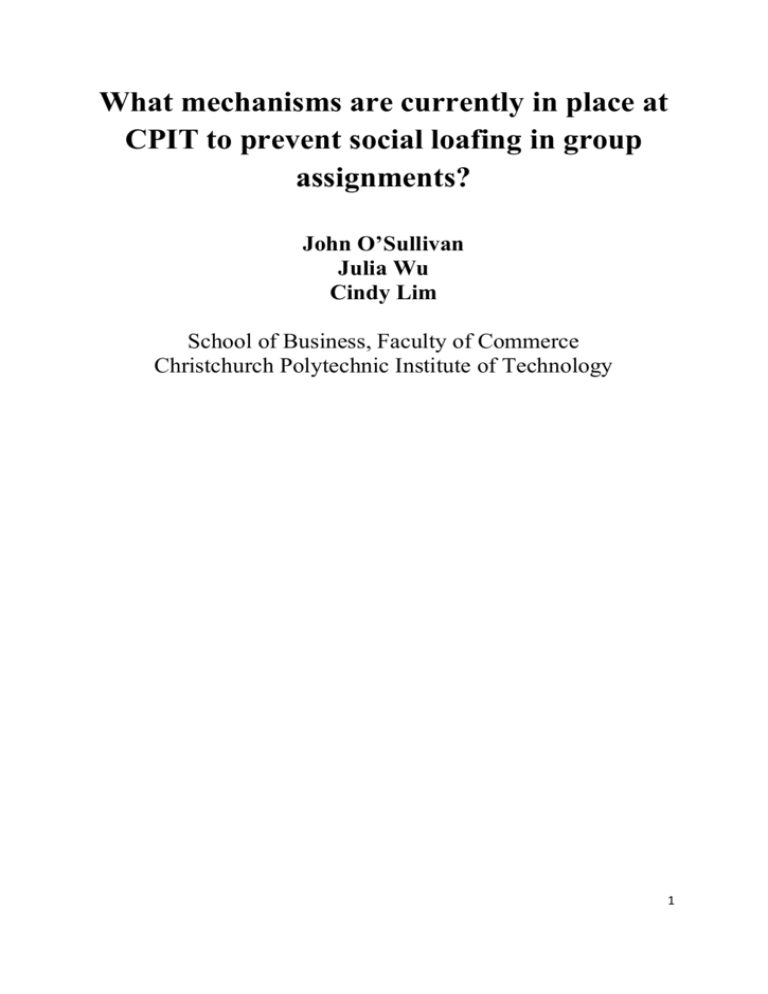
What mechanisms are currently in place at CPIT to prevent social loafing in group assignments? John O’Sullivan Julia Wu Cindy Lim School of Business, Faculty of Commerce Christchurch Polytechnic Institute of Technology 1 Abstract Tertiary institutions often make use of group assignments as a way of teaching students ‘soft skills’ and has a means of improving student learning, for example, improved analytical abilities, higher level of cognitive skills, and deeper learning as a result of pooling of labour.(Boud, Cohen & Sampson 1999; Jacques 1991,McDonald 1995). Both of these objectives however are dependent on all the members of a student work group participating fully. Social loafing is defined as Individual group members withholding effort but still achieving reward as long as they perceive that doing so will not affect their outcomes (Liden et al, 2004). Social loafing as a long observed social phenomenon (Karau and Williams (1993)) reduces the achievement of the above mentioned two objectives of group assignments. Mechanisms for preventing social loafing in student work groups is an area that requires further research. This paper is based on research undertaken to address the primary research question "what mechanisms are currently in place at CPIT to prevent social loafing in group assignments?" This research is intended to be exploratory. It involved a review of relevant literature and content analysis of all group assignment instructions for papers within the New Zealand Diploma of Business taught at C.P.I.T’s School of Business. Semi structured interviews with School of Business academic staff members whose papers contained group assignments were also conducted. This research documents current practice surrounding the design and implementation of group assignments; with particular focus on an academic context. It is expected that this research will produce insights that are transferrable to other contexts such as team tasks within work places. Key words: Education, Group assignments, Social Loafing I. Introduction Tertiary institutions often make use of group assignments as a way of teaching students ‘soft skills’ and has a means of improving student learning, for example, improved analytical abilities, higher level of cognitive skills, and deeper learning as a result of pooling of labour.(Boud, Cohen & Sampson 1999; Jacques 1991,McDonald 1995). Both of these objectives however are dependent on all the members of a student work group participating fully. Social loafing is defined as Individual 2 group members withholding effort but still achieving reward as long as they perceive that doing so will not affect their outcomes (Liden et al, 2004). Social loafing as a long observed social phenomenon (Karau and Williams (1993)) reduces the achievement of the above mentioned two objectives of group assignments. Mechanisms for preventing social loafing in student work groups is an area that requires further research. This paper is based on research undertaken to address the primary research question "what mechanisms are currently in place at CPIT to prevent social loafing in group assignments?" In answering this primary research question several secondary research questions were identified; such as: How are group assignments designed at the School of Business? What instructions are given to students regards social loafing at the School of Business? What methods of marking are utilised at the School of Business to prevent social loafing? How can academics overcome student hesitation to criticise the poor efforts of fellow students in group assignments? This research is intended to be exploratory. It involved a review of relevant literature and content analysis of all group assignment instructions for papers within the New Zealand Diploma of Business taught at C.P.I.T’s School of Business. Semi structured interviews with School of Business academic staff members whose papers contained group assignments were also conducted. This research documents current practice surrounding the design and implementation of group assignments; with particular focus on an academic context. It is expected that this research will produce insights that are transferrable to other contexts such as team tasks within work places. II. Literature review a. Social loafing – social psychology background 3 A common notion is that a collaborated effort and a sense of team participation lead to increased effort. That is, for many tasks, working collectively is overall more effective than working individually. However, Max Ringelmann (1861–1931), a French agricultural engineer, reported a contradicting observation finding an actual reduction of individual efforts in collaborative settings. Ringelmann’s finding that while the output of groups increases as they grow larger, the gain in productivity becomes less for each new member added. This is known as ‘Ringelmann’s Effect’ (Ingham, Levinger, Graves, and Peckham, 1974). It is believed that the Ringelmann’s Effect started the research on social loafing of more than a hundred years (Kravitz and Martin, 1986). Social loafing has been defined as the tendency of individuals to exert less effort when working collectively than individually (Karau and Williams, 1993). Since first defined, a number of key variables have been found to influence social loafing effects (Karau and Williams, 1993): The social impact or pressure (Latane, Williams, and Harkins, 1979) The identifiability of the participants (Williams, Harkins, and Latane, 1981) Task difficulty (Harkins and Petty, 1982); and The motivation factors e.g. being punished for lack of performance (Harkins and Jackson, 1985) The evaluation of their performance by either the group or an influential individual (Harkins and Szymanski, 1988, 1989; Szymanski and Harkins, 1993) The expectations of the co-workers (Williams and Karau, 1991). Latane, Williams, and Harkins (1979) explained social loafing through the social impact theory. Social impact can be interpreted as a pressure. From this perspective, assuming people will work in proportion to the pressure they feel, then bigger group sizes should result in less individual effort. In other words, participants in collective conditions feel less pressured to work hard, and therefore their outputs are lower than a sum of those working individually. 4 Williams, Harkins, and Latane (1981) argued that in collective settings, participants would perform better if their work was identifiable to other people, particularly if the others were sources of reinforcement or appraisal. Williams et al (1981) supported this argument with two experiments in which male undergraduates shouted and clapped alone and in groups with varying levels of identifiability. As predicted, participants who were always identifiable exerted a similar effort in both individual and group conditions. Harkins and Petty (1982) found that as tasks become more difficult and participants perceive they can make a more unique contribution to the task, social loafing decreases. During their experiment, participants in the more difficult object-group condition generated greater output for the task where the outcomes were judged to be more unique. This finding is interpreted as that social loafing occurs when people feel that the task is boring or mundane and that their contribution to the group is not identifiable. Harkins and Jackson (1985) argued that social loafing is affected by both an individual's perceived dispensability, as well as expectations concerning others' intended efforts. In collective settings, participants may perceive that they cannot or will not obtain rewards or punishments for their output. When participants’ performance was identifiable and comparable, they performed better than participants in all other conditions. Thus, Harkins and Jackson concluded that motivation could stem from people’s awareness that their performance can be identified and compared. Following this notion, Harkins and Szymanski (1988) and (1989) found that both individual evaluation and group evaluation contribute in reducing social loafing. Harkins and Szymanski, (1988) and Szymanski and Harkins (1993) argue that both self-evaluation and experimenter evaluation produce performance greater than that found in a `no evaluation' control group. Harkins and Szymanski (1989) suggest that to effectively eliminate social loafing, participants must perceive that 5 not only that their individual outputs are identifiable as suggested by Williams, Harkins, and Latane (1981), but also that these outputs can be evaluated through comparison with the outputs of their coworkers. Williams and Karau (1991) demonstrate that individuals may actually work harder collectively than individually when they expect their co-workers to perform poorly on a meaningful task, an effect we refer to as social compensation. They further interpret social compensation and social loafing in terms of a Collective Effort Model (CEM) that integrates key elements of expectancy-value approaches to work motivation. Individual effort leads to individual performance which contributes to group performance. In achieving effectiveness, group performance should lead to a group outcome that is valued by the individual, and the group outcome should be also perceived through a personally valued individual outcome or perceived personal benefits (Lanik, 2005). In summary, social loafing is associated with: Group settings: size of the group (identifiability), social impact (pressure), group and manager evaluation (Williams, Harkins, and Latane, 1981; Latane, Williams, and Harkins, 1979; Szymanski and Harkins, 1993 ;). Task related setting: level of difficulties (Harkins and Petty, 1982) Individual perception: percieved individual outcome, self-evaluation, expectations of the co-workers (Harkins and Szymanski, 1988 and 1989; Williams and Karau, 1991). Although the phenomenon of social loafing has been studied for decades, a consensus concerning the underlying basis for social loafing, has yet to be achieved. b. Social loafing and collective learning in business education Because “group-based decision making” continues to be a common and integral element of the daily activities of business organisations, collective learning has been widely used in either on-job training within a professional organisation or classroom education in commerce degrees (Kotey, 2007; 6 Masselli, Ricketts, and Martindale, 2001; and Michaelsen, Fink, and Knight, 1997). In addition to the unsettled argument of the underlying basis for social loafing, which is a negative synergy of group activities, educational research also present mixed empirical results about the relationship of collective learning and academic performance (Yazici, 2005). There are also arguments about the distinctions between “collective learning”, “cooporative learning”, and “learning in social interactions” (Laat & Simons, 2006). This research adopts the term of “collective learning” by Laat & Simons(2006, pg15), where students ‘consciously strive from common learning and/or working outcomes’. In this research, the terms of “collective learning”, “colleborative learning” and “group learning” are inter-changeable. It is believed that collaborative learning can facilitate the understanding of concepts and development of decision making and problem solving skills (Martin, Gannaway, Barnes and Prichard 2005). Beenen, et al (2004) summarised that in the collective learning enviroment, two questions are of interest: 1) Has each individual student sufficiently achieved the learning outcome? 2) Have all students in the group benefited from the collective learning process? Successful collective learning should be able to affirmatively answer the above two questions. Laat & Simons (2006) illustrated four issues of effective learning, of which three are collective: a) individual learning processes leading to collective outcomes, b) collective processes with individual outcomes, and c) collective process with collective outcome. Therefore, the concern of effective collective learning can be achieved by steming from indiviudal learning toward learning through collective process toward collective outcome. Individual and collective learning processes and outcomes (adapted from Laat & Simons (2006)) Outcomes Individual Collective 7 Processes Individual Learning Individual b) collective processes with individual outcomes Collective a) individual learning processes c) collective process with leading to collective outcomes collective outcome Scarborough (2006) and Michaelse et al (1997) pointed out that social loafing is one of the top three problems hindering the performance of collective learning. The other problems are individual dominance and the ‘sucker effect’. The sucker effect was originally identified as a particular form of social loafing and stems from the perceptions that others in the group are withholding, or intend to withhold effort. Individuals who hold this perception then withhold effort themselves to avoid being played for a "sucker" (Robbins, 1995). III. Practices aiming at eliminating social loafing - Practices in CPIT In this section, the current practices of CPIT assessments were evidenced by interviewing school of business lecturers, who had formal group assessments. The current practices were classified to reflect the literature. According to Scarborough (2006) and Michaelse et al (1997) social loafing, individual dominance and the ‘sucker effect’ steming from the social loafing effect, are common group learning issues. Three CPIT lecturers were invited to reflect on their experiences of arranging group assessment and facilitating formal and informal group learnings. Interview data supported the existance of social loafing and ‘sucker effect’. Having policies and procedures established to deal with these issues may not automatically ensure the effectiveness of group learning. This research also questions that whether group learning is more effective than indivudial learning. a. Managing group formation - Names in the Hat One of the lecturers in CPIT business school provided interview accounts of forming students groups by random selections. She placed all students’ names in a hat and got one student to pick two others name from the hat to form a group of three members. However she agreed that this worked well only for first year students who were not familiar with other students in their class. 8 For students to accept the group assignment per se was not an easy task. Another lecturer also stated that many students had voiced the opinion that they did not like group assignments because they felt that the mark their group achieved was less then what they could achieve on their own. Also the time required to meet as a group and decide how to approach the task were seen as time that could be better spent on other activities. The soft skills gained by group work did not get mentioned by students and they did not seem to value them. The same lecturer further explained that this perhaps reflected the current assessment focus by students on tangible outcomes. This research argues that in the context of CPIT School of Business, especially for New Zealand Diploma of Business papers, the assessment was designed to reflect the NZQA prescribed learning outcomes. The soft skills that can be achieved through the process of group learning and group assignment are usually not included as an assessable item. Therefore, the soft skills cannot be incorporated into the assessments, thus cannot be communicated to and accepted by students effectively. b. Managing group formation - Students to form their own group It is common to allow students to form their own groups in completing group assignments. According to the interview script, students formed their own group and selected their own group members when the assignment was issued. A lecturer reflected on his own experience as a student, he stated that, as a student whenever he was in a class with a group assignment, he would from the first or second class start thinking about who he wanted to work with and would try to get some form of commitment from them regards working together. His selection would be based on the personality of the potential group member and whether he felt confident their work would meet at least a passing grade. It is also confirmed by the interview accounts of lecturers that, it was noteworthy that some that students pursued the same strategy. Often only students, who were not regarded as ‘popular’ or international students, had not formed a group in the class when the group assignments were formally 9 issued. This may reflected that students, when forming the groups, intended to place reliance on the group members whom they believed would contribute. However, to what extend such reliance can be regarded as an intention of social loafing was not able to be judged. On the other hand, it demonstrated that students were aware of the likelihood of social loafing behaviour and tried to avoid including possible free riders in the group. c. Managing group formation - International students in group works When students were given the chance to form their own groups, it was observed that international students tended to almost always form groups comprised of just international students and did not often join groups with mainly domestic students. At the same time, some domestic students voiced opinions that having international students join their group may create extra editing and group coordination issues which they feared might drag down their mark. This phenomenon could hinder the effectiveness of the group learning. Meanwhile it is noteworthy that students who were involved in group assignments were aware of social loafing behaviours. Because of such awareness, students were reluctant to contribute in a group assignment, as much as they would in an individual based assessment. They perceived it was unfair that they could potentially contribute more to the group assignment if the outcome was also ‘enjoyed’ by the other group members who contributed less. d. Establishing positive work relationship in group setting A lecturer of CPIT school of business revealed that it was hoped that during the process of group learning, students were able to share and lead other group members and thus encourage team spirit and effort. Where there were disputes in a group, students were expected to play positive roles in encouraging their groups to compromise, resolve and minimise dysfunction within group members. Several accounts established that friendship and trust were developed when group members assisted and supported one another in the group learning process. However, other interview scripts also revealed that when setting a group assignment, lecturers found often they had to mediate between group members in terms of group member’s expectations. Many students expressed that it was difficult to stay in touch with their group members or to have their 10 group members up to a standard they could agree with. In these situations students often requested the lecturers to contact their group members and discuss with them the concerns. One lecturer expressed that the induction session of the group assignment was vitaly important. When a group assignment was issued, a lecturer could spend considerable time explaining to the students that issues in managing the group work among themselves were common rather than not. Students were expected to be able to manage different personality, background, time schedule among themselves, and this process per se is a process of group learning. It was also important that the lecturer should demonstrate and explain some of the common approaches of managing group work. However, another lecturer took on a more hands on approach, she usually required students to inform her when groups members were not performing or not contributing to the work early in the process. She also continuously advised on the group work. e. Putting effective group process in place – having a group leader. Interview data revealed that lecturers in CPIT school of business employed different strategies in order for their group work to be effective. A leader was expected to ensure that group members were aware of the work or task delegation and completion of work as per scheduled in the weekly meeting. Planning and controlling of group discussion and meeting datelines were set out clearly for each meeting. It was also interesting to notice that when the group assignment involve an oral presentation, the student who was responsible for presenting the group work was presumed to be the group leader. These practices experienced some resistance as the group leader presumably needed to take on extra work load for administrating the group work, for example, laison with group members. He was also the group member who felt more pressured especially when there were disputes within the group. However, being a group leader was not rewarded with more marks in the overall group assignment. f. Putting effective group process in place - managing peer rating systems Implementing a peer rating system to allow members of the group to rate each other work contribution to the group work was a common practice in CPIT school of business. Interview data 11 revealed that students may have reached an agreement to rank each other equally to prevent their relationship going sour. Especially, international students seemed to be unwilling to officially criticise fellow international student group members. Furthermore, if the group assignment involved any form of peer appraisal, almost always everyone ranked each-other’s contribution as equal, even if previously they had mentioned having problems co-ordinating the efforts of everyone in the group. An interviewee expressed that in his experience, both domestic and international students seemed to be unwilling to utilise peer appraisal mechanisms in group assignments to criticise the contribution of fellow group members. Invariably everyone’s contribution was ranked as equal. There were only two situations accounted for by the interviewees where tutors had groups who had not ranked everyone’s contribution as equal for an assignment. In both situations the person whose contribution was viewed as unequal strongly felt that the other group members had not advised him/her of their concerns nor given him/her the opportunity to improve their contribution before submitting. The interviewee further said ‘in both situations as lecturer I had to mediate between the parts to come to resolution that both parties viewed as fair. Usually this involved the party whose contribution was considered unequal to accept a symbolic lowering of their mark. So instead of receiving 100% of the mark awarded to the group they would have received 90% etc.’ IV. Conclusion, limitations and future research This research provided empirical evident to support Laat & Simons (2006), Scarborough (2006) and Michaelse et al (1997). Putting the business education in the context of the development of modern organisations, the research results demonstrated that the use of teams became pervasive. There have been four papers offered by CPIT School of business incorporated formal group assignments as formal assessments. In designing and managing the group assignments, efforts have been made in order to eliminate social loafing and maximising the effectiveness of group learning. The research found that students were to a great extend aware of social loafing effect. Such awareness may have caused resistance to group assignments. At the same time the ‘sucker effect’ also existed. It was demonstrated that students who perceived the likelihood and impact of social loafing effect, may 12 themselves withhold efforts that should have been put into the group assignment. The ‘sucker effect’ is reflected by the behaviour of (1) trying to exclude certain group members as well as putting reliance on other group members, (2) resistance of acting or selecting group leaders; and (3) negotiating in peer evaluation to rank each other’s performance equally. The interview data also revealed issues of group assignment caused by the different culture orientation of the students especially in New Zealand where classrooms consists students of multinational and multicultural background. The research further questions that the effectiveness of group assignments could not be achieved considering the current assessment prescription. The NZQA prescribed learning outcomes do not formally recognised the skills of managing group work as an assessable item, therefore the expected outcome of group learning cannot be communicated to and accepted by students. It is hoped that the future research in this area could further the investigation of what subjects were suitable to be assessed through group assignments, and synthesising the efforts in the context of business education in promoting the effectiveness of group learning. Reference list Ballatine, J., and Larres, O. M. (2007). Cooperative Learning: a Pedagogy to Improve Students' Generic Skills. Education and Training , 49 (2), 126-137. Beenen, G., Ling, K., Wang, X., Chang, K., Frankowski, D., Resnick, P., et al. (2004). Using Social Psychology to Motivate Contributions to Online Communities. CommunityLab; CSCW'04 . Cox, P., and Bobrowski, P. (2000). The Team Charter Assignment: Improving the Effectiveness of Classroom Teaching. The Journal of Behavioral and Applied Management , 1 (1), 92. Dick, R. v., Tissington, P. A., and Hertel, G. (2009). Do many hands make light work?: How to overcome social loafing and gain motivation in work teams. European Business Review , 21 (3), 233-245(13). 13 Dihl, M. (2008). Finding Teammates who are not Prone to Suckers and Free-Rider Effects: The Protestant Work Ethic as a Moderator of Motivation Losses in Group. Group Processes and Intergroup Relations , 11 (1), 39-54. Dommeyer, C. (2006). Students' Attitudes toward a New Method for Preventing Loafing on the Group Project: the Team Activity Diary. Journal of College Teaching and Learning , 3 (1), 15-22. Dommeyer, C. (2007). Using the Diary Method to Deal with Social Loafers on the Group Project: Its effects on Peer Evaluations, Group Behaviour and Attitudes. Journal of Marking Education , 29 (2), 175-188. Gannaway, Y. M., Barnes, J., and Richard, I. (2005). Evaluating the Use of Collaborative Learning Assessment: Case Study in Psychology Research Method. Making a Difference:2005 Evaluation and Assessment Conference, (pp. 65-73). Sydney. Hardin, R. (2003, May 21). Three Rider Problem. Retrieved September 04, 2009, from Stanford Encyclopedioa of Philosophy: http://plato.stanford.edu/entries/free-rider/ Harkins, S. G., and Jackson, J. M. (1985). The Role of Evaluation in Eliminating Social Loafing. Personality and Social Psychology Bulletin , 11 (4), 457-465 . Harkins, S. M., and Szymanski, K. (1988). Social Loafing and Self-evaluation with an objective Standard. Journal of Applied Behavioral Science , 11 (2), 210-219. Harkins, S., and Szymanski, K. (1989). Social loafing and Group Evaluation. Journal of Personality and Social Psychology , 56, 934-941. Houldsworth, C., and Mathews, B. P. (2000). Group composition, performance and educational attainment. Education and Training , 42 (1), 40-53. Ingham, A., Levinger, G., Graves, J., and Peckham, V. (1974). The Ringelmann Effect: Studies of group size and group performance. Journal of Experimental Social Psychology , 10, 371-84. 14 Karau, S., and Williams, K. (1993). Social Loafing: A Meta-Alalytic Review and Theoretical Integration. Journal of Personality and Social Psychology , 45 (4), 681-706. King, P., and Behnke, R. (2005). Problems Associated with Valuating Student Performance in Groups. College Teaching , 53. Kotey, B. (2007). Teaching the Attributes of Venture Teamwork in Teritary Enterpreneurship Programmes. Education and Training , 49 (8/9), 634-655. Kravitz, D. A., and Martin, B. (1986). Ringelmann Rediscovered: the Original Article. Journal of Personality and social Psychology , 45 (4), 681-706. Laat, M. d., and Simons, R.-J. (2006). Collective Learning: Theoretical Perspectives and Ways to Support Network Learning. Vocational Training - European Journal (27), 13-24. Lanik, M. (April 2005). Interpersonal Compatibility and Social Loafing. Soundings, a Publication of the University Honors Program , HONS 4960, 49-53. Latane, B., Williams, K., and Harkins, S. (1979). Many Hands Make Light The Work: The Causes and Consequences of Social Loafing. Journal of Personality and Social Psychology , 37, 822-832. Levin, P. (2003, January). Running Group Projects: Dealing with the Free-rider Problem. PLANET, London School of Economics (5), pp. 7-8. Masselli, J., Ricketts, R., and Martindale, B. Chapter 1 Applying Group and Team Learning Concepts in Tax Classes. In Methods, Topic, and Issues in Tax Education: A Year 2001 Perspective (pp. 319). Michaelsen, L. K., Fink, L. D., and Knight, A. (1997). Designing Effective Group Activities: Lessons for Classroom Teaching and Faculty Development. In D. DeZure (Ed.), To Improve the Academy: Resources for Faculty, Instructional and Organisational Development. Stillwater, OK: New Forums. 15 North, A. C., Linley, P. A., and Hargreaves, D. J. (2000). Social Loafing in a Co-operative Classroom Task. Educational Psychology , 20 (4), 389-392(4). Piezon, S. L., and Donaldson, R. L. (Winter 2005). Online Groups and Social Loafing: Understanding Student-Group Interactions. Online Jpurnal of Distance Learning Administration , VIII (IV). Robbins, T. (1995). Social Loafing on Cognitive Tasks: an examination of the 'Sucker Effect'. Jounral of Business and Psychology , 9 (3), 337-342. Scarborough, J. D. (2005) The Scholarship of Teaching: The CEET Initiative on Teaching and Learning. A Faculty Development Program on Teaching and Learning and Classroom Research. Volumes 1-4. October 2005-December 2006 Szymanski, K., and Harkins, S. (1993). The effect of experimenter evaluation on self-evaluation within the social loafing paradigm. Journal of Experimental social Psychology , 268-286. Williams, K. D., and Karau, S. J. (1991). Social loafing and social compensation: The effects of expectations of co-worker performance. Journal of Personality and Social Psychology (61), 570581. Williams, K. D., Harkins, S. G., and Latane, B. (1981). Identifiability as a Deterrent to Social Loafing: Two Cheering Experiments. Journal of Personality and Social Psychology , 40, 303-311. Yazici, H. J. (2005). A Study of Collaborative Learning Style and Team Learning Performance. Education and training , 47 (3), 216-229. 16
